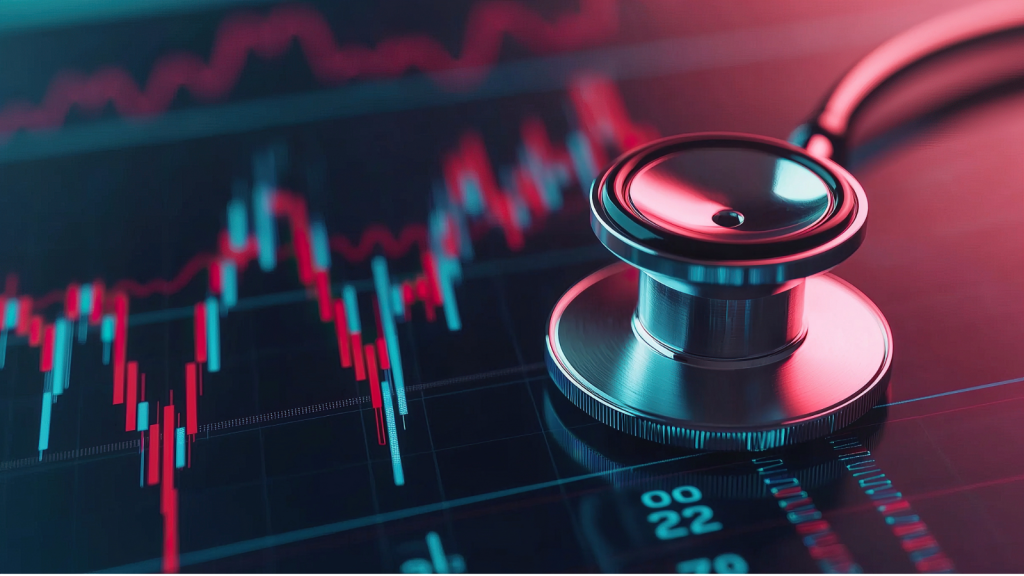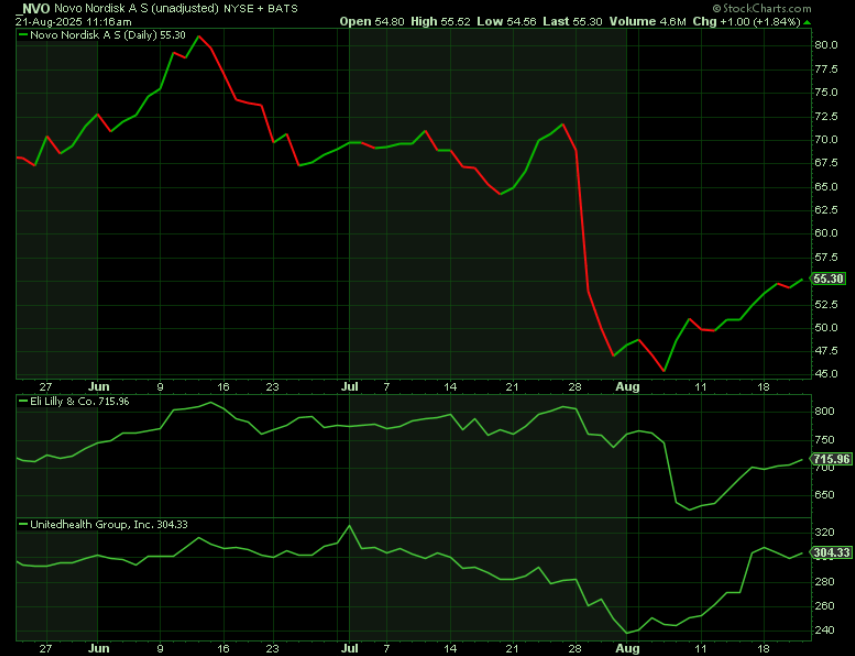Buffett Is Buying Healthcare Stocks – Should You?


The most profitable trades in history often begin in moments of panic. And few moments felt more hopeless than the fall of 2008…
As more and more borrowers began defaulting on their mortgages, the housing bubble began to burst. Banks were imploding, with many of their stocks cratering 80%-plus. Lehman collapsed and filed for bankruptcy. Citigroup (C) looked like it was going to zero. Bank of America (BAC) was scrambling to absorb Merrill Lynch while propped up by federal bailout funds. And the public’s faith in the entire financial system had evaporated.
The big fear was that the world’s financial arteries had clogged, and no amount of Wall Street stents could keep the system alive.
But then those same “dead” bank stocks staged one of the greatest comebacks of all time.
The U.S. government backstopped the system with the Emergency Economic Stabilization Act of 2008, bailing out Goldman Sachs (GS), JPMorgan Chase (JPM), Morgan Stanley (MS), and Wells Fargo (WFC), among others.
Soon enough, earnings rebounded, dividends were reinstated, and shares went on a multi-year tear. Buying banks post-crisis became a career-defining trade.
For investors bold enough to look past the panic, banks offered life-changing returns. Today, some of those same investors are eyeing healthcare: a sector under pressure – but one that may be setting up for its own rebound story…
The Great Healthcare Selloff
Three giants – Novo Nordisk (NVO), Eli Lilly (LLY), and UnitedHealth Group (UNH) – are at the center of the storm.
These aren’t speculative biotechs or obscure insurers. They are the blue chips of global healthcare, each worth hundreds of billions – the kind of stocks investors usually buy to sleep better at night.
And yet they’ve been anything but sleepy lately:
- Novo Nordisk, once a European crown jewel and the face of the obesity-drug revolution, recently lost nearly a third of its value as investors panicked over slowing sales of Ozempic and Wegovy, cheaper compounded competitors, and political pressure on drug pricing. $90-plus billion in market cap was vaporized.
- Eli Lilly, the other half of the weight-loss duopoly, tumbled hard after trial results for its oral obesity pill underwhelmed – despite beating earnings and raising guidance. Investors had priced in perfection, and when perfection didn’t arrive, the stock fell double digits.
- UnitedHealth Group, the fortress insurer that seemed immune to everything from pandemics to recessions, has also suddenly cracked. A cocktail of surging medical costs, federal scrutiny, and operational missteps drove the stock down more than 40%: its worst performance since the 2008 crisis.
These are three of the 10 largest healthcare companies in the world. If they can crack, no stock in the sector feels safe.
Déjà Vu: What Banks Taught Us About Panic and Recovery
These comparisons to the great financial crisis aren’t just lazy metaphor. The rhyme is real.
In 2008, toxic mortgage securities shattered confidence. The Fed was behind the curve. Banks looked untrustworthy. The whole system seemed broken.
Today, the same fear is spreading in healthcare. If Novo and Lilly can’t deliver blockbuster growth on obesity drugs, what’s left? If UnitedHealth can’t manage medical costs, what insurer can? If politicians are lining up to slash prices, can anyone in the industry escape margin compression?
The result is the same: panic, capitulation, and the sense that a ‘golden age’ is over.
But in 2008, that consensus was dead wrong. And in 2025, it could be dead wrong again.
The Bull Case for Beaten-Down Healthcare Stocks
First, structural demand hasn’t gone anywhere.
Time marches on. People around the world will continue to age and get sick, and chronic disease doesn’t take holidays. The healthcare system is one of the few sectors guaranteed long-term demand growth, no matter the election cycle or economic conditions.
Second, the obesity drug story is far from over.
Yes, Novo and Lilly stumbled. But they still control two of the most successful drug franchises in history. Wegovy, Ozempic, Mounjaro, Zepbound – these names have already reshaped global medicine. Future indications (liver disease, cardiovascular protection, sleep apnea) could multiply their market reach. One disappointing pill trial doesn’t negate an entire franchise.
Third, UnitedHealth isn’t Lehman Brothers.
The company remains one of the largest insurers on the planet, with a dominant position in Medicare Advantage, employer coverage, and healthcare services. Costs are high now, but cost cycles ebb and flow.
And let’s not forget: Warren Buffett himself just bought the dip – to the tune of $1.6 billion. Buffett doesn’t panic; he waits for others to, then he buys.
Investing Lessons From Crisis to Comeback
The critical lesson of 2008 was simple: don’t confuse cyclical pain with existential death.
Yes, banks nearly drowned; but the government had every incentive to throw them a lifeline. They didn’t go away, and the survivors got stronger.
Now apply that to today’s healthcare mess:
- The government won’t let the U.S. healthcare system collapse. It’s too central to the economy, too vital to the electorate.
- Obesity, diabetes, cancer, heart disease… They aren’t going away. Demand for drugs, insurers, hospitals, and care systems is only going up.
- Short-term earnings hits, regulatory fears, and trial disappointments are painful but temporary. The long-term trajectory is growth.
In 2009, investors who saw through the fear and bought into the panic made fortunes. The same could be true today with healthcare stocks.
- Valuation Reset: After years of trading at frothy multiples, Novo, Lilly, and UnitedHealth now trade at ultra-discounted valuations. Novo stock, for example, trades at just 13X forward earnings – about 52% below its five-year average multiple. For defensive, cash-flow-rich giants, massive discounts like this have historically been great buying opportunities.
- Buffett Effect: Berkshire’s entry into UnitedHealth is no small thing. It signals that, just like with banks in 2009, prescient investors are sniffing out opportunity in a hated sector. Other well-known names bought UnitedHealth stock last quarter, too – like Michael Burry and billionaire David Tepper. The stock is now very widely owned by the “smart money.”
- Pipelines and Innovation: Lilly’s GLP-1 franchise, Novo’s expanding indications, gene therapy pipelines, AI-driven drug discovery, new payment models – innovation isn’t slowing. It’s accelerating. The market just forgot in a moment of panic.
- Rotation Potential: Tech has sucked all the oxygen out of the stock market room. But when sentiment shifts, beaten-up healthcare names could become the defensive, dividend-paying darlings again; just as banks did after 2009.
The Next Bull Run?
Of course, not everyone is buying the “2008 moment” narrative.
Skeptics point out that political risk, obesity-drug commoditization, and structural cost inflation are real threats. All true.
But that’s exactly what bears said about banks in 2008 – that they were finished. And they weren’t.
The survivors thrived. Now the same dynamic could be in play for healthcare.
Novo Nordisk, Eli Lilly, and UnitedHealth have been hammered. Sentiment is toxic. Headlines scream collapse. But these companies still dominate their fields, spin off mountains of cash, and serve markets that only expand.
In 2008, investors who sold at the bottom lost fortunes. Those who bought into the panic made them.
If history rhymes, then today’s fear won’t mark the end of healthcare’s golden age but the beginning of its next great bull run… Because if there’s one sector as systemically vital as finance, it’s healthcare. And like the banks in 2009, the survivors won’t just live; they’ll flourish.
Yet, here’s the bigger truth: healthcare isn’t the only sector facing a reckoning…
Across the market, the next 12 to 24 months are shaping up as an Age of Chaos: a period when stock prices soar and crash at light speed. Millionaires will go broke overnight, and unknown companies will multiply tenfold.
My colleague, renowned futurist Eric Fry, has identified seven trades designed to protect and multiply wealth through this turbulence. Some involve dumping household names that look untouchable. Others involve scooping up fast-growing innovators that could be the next Amazon (AMZN) – before Wall Street wakes up.
When chaos reigns, fortunes shift hands. If 2008 taught us anything, it’s that panic creates opportunity. And right now, Eric Fry is showing readers how to seize it.










